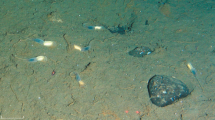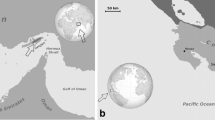Abstract
Analysis of the gut contents and scanning electron microscopy examination of the benthic hydroidSilicularia rosea from intertidal communities of Potter Cove (King George Island, South Shetlands) suggest that diatoms are the principal source of food for this species. The great number of items captured daily by each polyp (a mean of 287 in January and 162 in December) and the benthic origin of these prey items suggest an adaptation to daily resuspension processes caused by tidal currents. This is an unusual trophic strategy for a benthic hydroid, which would result in an important degree of independence from the highly fluctuating planktonic food conditions in Antarctic waters.
Similar content being viewed by others
References
Ahn IY (1994) Feeding ecology and physiology of the Antarctic lamellibranchLaternula elliptica (Laternulidae) in Marian Cove and vicinity, King George Island during an austral summer. SCAR 6th Biology Symposium: Antarctic communities: species, structure and survival. Abstracts. Venice, SCAR, Italy, p 3
Ahn IY, Kang JS, Kang SH (1993) Primary food sources for shallowwater benthic fauna in Marian Cove. King George Island during an austral summer. Korean J Polar Res 4:67–72
Arntz WE, Brey T, Gallardo VA (1994) Antarctic zoobenthos. Oceanogr Mar Biol Annu Rev 32:241–304
Barangé M, Gili JM (1988) Feeding cycles and prey capture inEudendrium racemosum (Cavolini, 1785). J Exp Mar Biol Ecol 115:281–293
Barangé M, Zabala M, Riera T, Gili JM (1989) A general approach to thein situ energy budget ofEudendrium racemosum (Cnidaria, Hydrozoa) in the Western Mediterranean. Scientia Marina 53:423–427
Bathmann U, Fisher G, Müller PJ, Gerdes D (1991) Short-term variations in particulate matter sedimentation off Kapp Norvegia, Weddell Sea, Antarctica: relation to water mass advection, ice cover, plankton biomass and feeding activity. Polar Biol 11:185–195
Boero F (1984) The ecology of marine hydroids and effects of environmental factors: a review. Publicazione de la Station Zoologica di Nopoli. I. Marine Ecology 5:93–118
Brey T, Clarke A (1993) Population dynamics of marine benthic invertebrates in Antarctic and Sub-Antarctic environments: Are there unique adaptations? Antarct Sci 5:253–266
Bullivant JS, Dearborn JH (1967) The fauna of the Ross Sea. NZ Dep Sci Indust Res Bull 176:1–76
Catewicz Z, Kowalik Z (1983) Harmonic analysis of tides in Admiralty Bay. Oceanologia 15:97–109
Christensen H (1976) Ecology ofHydractinia echinata. I. Feeding biology. Ophelia 4:245–275
Coma R, Gili JM, Zabala M (1995) Trophic ecology of the benthic marine hydroidCampanularia everta. Mar Ecol Prog Ser 119:211–220
Conover RJ (1978) Transformation of organic matter. In: Kinne O (ed) Marine ecology, vol 4. Wiley, New York, pp 221–499
Cornelius PFS, Östman C (1987) Redescription ofLaomedea exigua M. Sars, a hydroid new to Scandinavia, with comments on its nematocysts, life cycles and feeding movements. Zool Scr 16:1–8
Dayton PK, Robilliard GA, De Vries AL (1969) Anchor ice formation in McMurdo Sound. Antarctica, and its biological effects. Science 163:273–274
Edler E (1979) Recommendations for marine biological studies in the Baltic Sea: phytoplankton and chlorophyll. Baltic Mar Biol Publ 5:1–38
Fabricius KE, Benayahu Y, Genin A (1995) Herbivory in assymbiotic soft corals. Science 268:90–92
Forbes E (1991) Sea-level observation in the Antarctic Region by the Republica Oriental del Uruguay. II. Harmonic analysis. Korean J Polar Res 2:193–195.
Gaino E, Bavestrello G, Cattaneo-Vietti R, Sarà M (1994) Scanning electron microscope evidence for diatom uptake by two Antarctic sponges. Polar Biol 14:55–58
Gili JM, Hughes RG (1995) Ecology of benthic hydroids. Oceanogr Mar Biol Annu Rev 33:351–422
Gili JM, Hughes RG, Alvà V (1996) Feeding cycles and prey capture ofTubularia larynx. Ellis and Solander, 1786. Scientia Marina 60:43–54
Griffiths CE, Griffiths RJ (1987) Bivalvia. In: Pandian TJ, Vernberg FJ (eds) Animal energetics, vol. 2. Academic Press, San Diego, pp 1–88
Harris VA (1990) Sessile animals on the sea shore. Chapman & Hall, London
Hunter T (1989) Suspension feeding in oscillating flow: the effect of colony morphology and flow regime on plankton capture by the hydroidObelia longisima. Biol Bull 176:41–49
Jackson JBC (1979) Morphological strategies of sessile animals. In: Earwood GP, Rosen BR (eds) Biology and systematics of colonial organisms. Academic Press, New York, pp 499–555
Jarre-Teichmann A, Brey T, Bathmann UV, Dahm C, Dieckmann GS, Gorny M, Klages M, Pagès F, Plötz J, Schnack-Schiel SB, Stiller M, Arntz WE (in press). Trophic flows in the benthic shelf community of the eastern Weddell Sea, Antarctica. In: Battaglia B, Valencia J, Walton D (eds) Antarctic communities: species, structure and survival. Cambridge University Press, Cambridge
Jørgensen CB (1966) Biology of suspension feeding. Pergamon Press, Oxford
Kellogg DE, Kellogg TB, Dearborn JH, Edwards KC, Fratt DB (1982) Diatoms from brittle-star stomach contents: implications for sediment reworking. Antarct JUS 17:167–169
Klöser H (1994) Microphytobenthos as a food for filter feeding animals in Maxwell Bay. SCAR 6th Biology Symposium: Antarctic communities: species, structure and survival. Abstracts. Venice, SCAR, Italy, p 153
Koehl MAR (1977) Water flow and the morphology of zoanthid colonies. Proc 3rd Int Coral Reef Symp 1:437–444
La Barbera M (1984) Feeding currents and particle capture mechanisms in suspension feeding animals. Am Zool 24:71–84
Letunov V, Marfenin Y (1980) Some characteristics of feeding behaviour in winter colonies ofDynamena pumila under various temperature regimens. Biol Nauka Selsk Lesn Khoz 6:51–55
Levinton J (1977) Stability and trophic structure in deposit-feeding and suspension-feeding communities. Am Nat 106:472–486
Paffenhöfer GA (1968) Nahrungsaufnahme, Stoffumsatz und Energiehaushalt des marinen HydroidpolypenClava multicornis. Helgol Wiss Meeresunters 8:1–44
Ralph PM (1956) Variation inObelia geniculata (Linnaeus, 1758) andSilicularia bilabiata (Coughtrey, 1875) (Hydroida, F. Campanulariidae). Trans R Soc NZ 84:279–296
Rubenstein DI, Koehl MAR (1977) The mechanisms of filter feeding: some theoretical considerations. Am Nat 111:981–994
Schloss I, Klöser H, Ferreyra G, Curtosi A, Mercuri G, Pinola E (in press). Factors governing phytoplankton and particulate matter variation in Potter Cove, King George Island, Antarctica. In: Battoglia B, Valencia J, Walton D (eds) Antarlic communities: species, structure and survival. Cambridge University Press, Cambridge
Sebens KP, Koehl MAR (1984) Predation on zooplankton by the benthic anthozoansAlcyonium siderium (Alcyonacea) andMetridium senile (Actiniaria) in the New England subtidal. Mar Biol 81:255–271
Shimeta J, Jumars PA (1991) Physical mechanisms and rates of particle capture by suspension feeders. Oceanogr Mar Biol Annu Rev 29:191–257
Simkina RG (1980) A quantitative feeding study of the colonies ofPerigonimus megas (Hydroida, Bougainvillidae). Zool Zh 59:500–506
Van-Präet M (1985) Nutrition of sea anemones. Adv Mar Biol 22:65–99
Author information
Authors and Affiliations
Corresponding author
Rights and permissions
About this article
Cite this article
Gili, J.M., Alvà, V., Pagès, F. et al. Benthic diatoms as the major food source in the sub-Antarctic marine hydroidSilicularia rosea . Polar Biol 16, 507–512 (1996). https://doi.org/10.1007/BF02329070
Received:
Accepted:
Issue Date:
DOI: https://doi.org/10.1007/BF02329070




